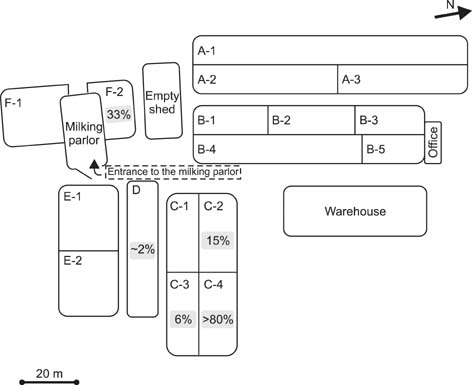J Vet Sci.
2015 Mar;16(1):87-92. 10.4142/jvs.2015.16.1.87.
Association of the time that elapsed from last vaccination with protective effectiveness against foot-and-mouth disease in small ruminants
- Affiliations
-
- 1Koret School of Veterinary Medicine, The Robert H. Smith Faculty of Agriculture, Food and Environment, The Hebrew University of Jerusalem, Rehovot 76100, Israel. udie79@gmail.com
- 2Israeli Veterinary Services, Beit Dagan 50250, Israel.
- 3Kimron Veterinary Institute, Beit Dagan 50250, Israel.
- 4Hachaklait Veterinary Services, Caesarea 30899, Israel.
- KMID: 2160824
- DOI: http://doi.org/10.4142/jvs.2015.16.1.87
Abstract
- Routine and emergency vaccination of small ruminants against foot-and-mouth disease (FMD) is mandatory in many endemic countries, yet data on the field effectiveness of the vaccines used is scarce. We conducted an investigation of a serotype O FMD outbreak that took place in a sheep and goat pen, and estimated the effectiveness of various routine vaccination statuses. We also evaluated the protection provided by colostrum administration and emergency vaccination. Animals which were routinely vaccinated twice were not clinically affected while disease incidence was observed among animals routinely vaccinated only once (p = 0.004 according to a two-sided Fisher's exact test). In groups vaccinated only once, there was a significant association between the average time that elapsed since last vaccination and the disease incidence (n = 5; Spearman correlation coefficient: r(s) = 1.0, p < 0.01). In addition, non-vaccinated lambs fed colostrum from dams vaccinated more than 2 months before parturition had a mortality rate of 33%. Administration of emergency vaccination 2 days after the occurrence of the index case was the probable reason for the rapid blocking of the FMD spread within 6 days from its onset in the pen.
Keyword
MeSH Terms
Figure
Reference
-
1. Argüello A, Castro N, Capote J, Ginés R, Acosta F, López JL. Effects of refrigeration, freezing-thawing and pasteurization on IgG goat colostrum preservation. Small Rumin Res. 2003; 48:135–139.
Article2. Barnett PV, Cox SJ. The role of small ruminants in the epidemiology and transmission of foot-and-mouth disease. Vet J. 1999; 158:6–13.
Article3. Cunliffe HR, Graves JH. Immunologic response of lambs to emulsified foot-and-mouth disease vaccine. Arch Gesamte Virusforsch. 1970; 32:261–268.
Article4. Doel TR. FMD vaccines. Virus Res. 2003; 91:81–99.
Article5. Donaldson AI. The role of sheep in the epidemiology of foot-and-mouth disease and proposals for control and eradication in animal populations with a high density of sheep. 2000 Session of the Research Group of the Standing Technical Committee of EuFMD. Appendix 10. Borovets: The European Commission for the control of Foot-and-Mouth Disease;2000. p. 107–114.6. Elnekave E, Li Y, Zamir L, Even-Tov B, Hamblin P, Gelman B, Hammond J, Klement E. The field effectiveness of routine and emergency vaccination with an inactivated vaccine against foot and mouth disease. Vaccine. 2013; 31:879–885.
Article7. Hughes GJ, Mioulet V, Kitching RP, Woolhouse ME, Alexandersen S, Donaldson AI. Foot-and-mouth disease virus infection of sheep: implications for diagnosis and control. Vet Rec. 2002; 150:724–727.
Article8. James AD, Rushton J. The economics of foot and mouth disease. Rev Sci Tech. 2002; 21:637–644.
Article9. Kitching RP, Hughes GJ. Clinical variation in foot and mouth disease: sheep and goats. Rev Sci Tech. 2002; 21:505–512.
Article10. Knowles NJ. FAO World Reference Laboratory for Foot-and-Mouth Disease (WRLFMD). Genotyping Report. Pirbright: Institute for Animal Health;2011. PMID: Ref No.: ISR/6/2011. Batch No.: WRLFMD/2011/00027.11. Knowles NJ. FAO World Reference Laboratory for Foot-and-Mouth Disease (WRLFMD). Genotyping Report. Pirbright: Institute for Animal Health;2011. PMID: Ref No.: ISR/11/2011 and ISR/13/2011. Batch No.: WRLFMD/2011/00038.12. Loste A, Ramos JJ, Fernández A, Ferrer LM, Lacasta D, Verde MT, Marca MC, Ortín A. Effect of colostrum treated by heat on immunological parameters in newborn lambs. Livest Sci. 2008; 117:176–183.
Article13. Mansley LM, Donaldson AI, Thrusfield MV, Honhold N. Destructive tension: mathematics versus experience–the progress and control of the 2001 foot and mouth disease epidemic in Great Britain. Rev Sci Tech. 2011; 30:483–498.
Article14. Musser JM. A practitioner's primer on foot-and-mouth disease. J Am Vet Med Assoc. 2004; 224:1261–1268.
Article15. Parida S. Vaccination against foot-and-mouth disease virus: strategies and effectiveness. Expert Rev Vaccines. 2009; 8:347–365.
Article16. Stram Y, Engel O, Rubinstein M, Kuznetzova L, Balaish M, Yadin H, Istumin S, Gelman B. Multiple invasions of O1 FMDV serotype into Israel revealed by genetic analysis of VP1 genes of Israeli's isolates from 1989 to 2007. Vet Microbiol. 2011; 147:398–402.
Article17. World Organisation for Animal Health. Manual of Diagnostic Tests and Vaccines or Terrestrial Animals (mammals, birds and bees). Chap. 2.1.5. Foot and Mouth Disease. 7th ed. Paris: OIE;2012. 2:p. 145–173.
- Full Text Links
- Actions
-
Cited
- CITED
-
- Close
- Share
- Similar articles
-
- Genetic identification and serological evaluation of commercial inactivated foot-and-mouth disease virus vaccine in pigs
- Requirements for improved vaccines against foot-and-mouth disease epidemics
- Hand, Foot, and Mouth Disease: Clinical and Virological Investigations
- Effect of simultaneous administration of foot-and-mouth disease (FMD) and anthrax vaccines on antibody response to FMD in sheep
- QS-21 enhances the early antibody response to oil adjuvant foot-and-mouth disease vaccine in cattle


